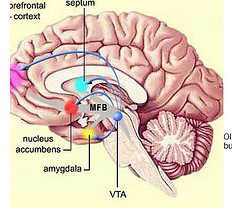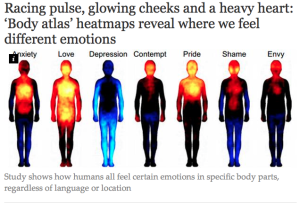Are Emotions in the Brain or Body?

As a part of my doctoral training in Neuroscience, we learned that the amygdala was the seat of all emotions. But as a person who suffered from depression, anxiety and panic attacks, I was well aware that that the emotions I felt were very strong in my chest and stomach, so I felt like something was missing in this explanation.
Since then, Western science has begun to expand its view on the subject. I’ve also learned that Eastern medicine has a very different take on the origins of emotions. There are interesting findings that we have from the Emotion Code, and body workers as well. Below I will summarize the different perspectives, and provide context to a unified understanding of where emotions come from, and where they go.
1. Chinese medicine believes specific emotions are associated with imbalances in your organs and glands.
I have definitely seen this. For example, if someone is not motivated to do something, they often have imbalances in the thyroid gland. One of the emotions associated with the thyroid is “overwhelm”, and interestingly, a symptom of hypothyroidism is fatigue. Other connections of organs or glands with emotions include, the liver with anger, the heart with joy, the lung with grief, and the kidney with fear.
2. Western science is starting to realize that emotions might be generated through the enteric nervous system in the gut.
There is a network of neurons lining our gut. So many that some scientists are calling it our “second brain”. There are 30 different neurotransmitters in the brain, and 95% of the body’s serotonin is in the gut. Serotonin is the neurotransmitter that is up-regulated with antidepressants. Scientist were shocked to learn that 90% of the fibers in the Vagus Nerve go from the gut to the brain and not the other way around.
Furthermore, there is more evidence showing that the makeup of the bacteria in the gut (the microbiome), can play an important role in our stress response, our emotional behavior and pain perception. There are a variety of different experiments showing that transplanting bacterial species to mice can affect their behavior!
3. According to the subconscious, emotions can be anywhere in the body
Dr. Bradley Nelson was a chiropractor when he discovered the idea of trapped emotions. He noticed that many of his patients were not getting well with adjustments alone. He also noticed that patients would often have emotional releases when adjusted on the table. When he figured out how to identify and release trapped emotions that were contributing to his client’s pain, he saw significant changes in his ability to help them heal!
Using his system called the Emotion Code, when we find a trapped emotion, we can identify where its located in the body, when it was trapped in the body and what caused it to be trapped!
So how do we make sense of all this?
 Candice Pert, Ph.D., author of Molecules of Emotion found that emotions can be stored anywhere. They are stored via peptide receptors, which are found in the organs, tissues, skin, muscles and endocrine glands. She also believes that unexpressed emotions are lodged in the body, and they need to be expressed for healing. She says they travel upwards through the spinal chord to be integrated by the brain. And it is the brain where you make sense of the emotions, and bring them into conscious awareness.
Candice Pert, Ph.D., author of Molecules of Emotion found that emotions can be stored anywhere. They are stored via peptide receptors, which are found in the organs, tissues, skin, muscles and endocrine glands. She also believes that unexpressed emotions are lodged in the body, and they need to be expressed for healing. She says they travel upwards through the spinal chord to be integrated by the brain. And it is the brain where you make sense of the emotions, and bring them into conscious awareness.
She also says that the cortex works to suppress and rationalize emotions, to prevent overload, so that we can be productive. If we stay in our heads, and out of our bodies, then the emotions cannot be expressed. This in turn causes illness.
The Emotion Code works on the principle that the key to healing is to release trapped emotions in the body. In addition to helping us clear emotional and behavioral struggles, we regularly release trapped emotions to strengthen immune systems and release physical pain. Thanks to the work of Dr. Candice Pert, discoveries from Neuroscience, Eastern Medicine and the Emotion Code become unified to explain where emotions come from, where they go, and how releasing them can help us heal!
Do you need help releasing trapped emotions? Call me at 1855 ENERJOY to schedule a free 1 hr consultation.
*Featured image is human-brains by Peta_de_Aztian @ Flicker.com
1 Comment
Trackbacks/Pingbacks
- Alberta Espree - Are Emotions in the Brain or Body? | LifeLong EnerJoy! [...]Early on, grief counseling could be useful.[...]





Yes.. for the events that are more traumatic. But we find that we can trap emotions from experiences that we don’t realize are impacting us as well.